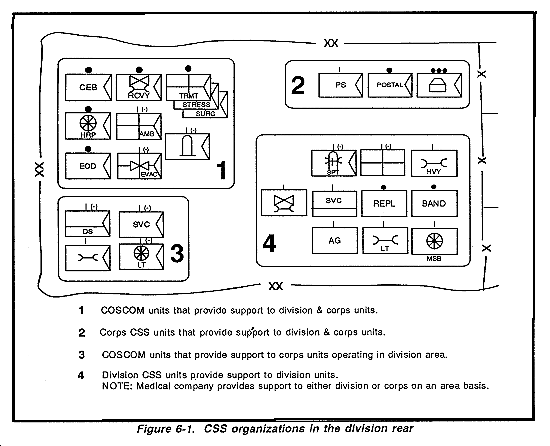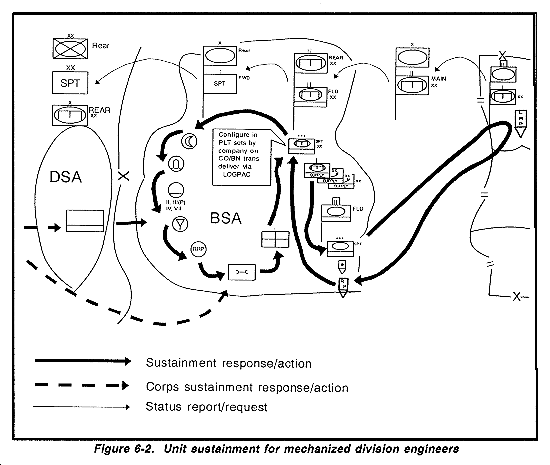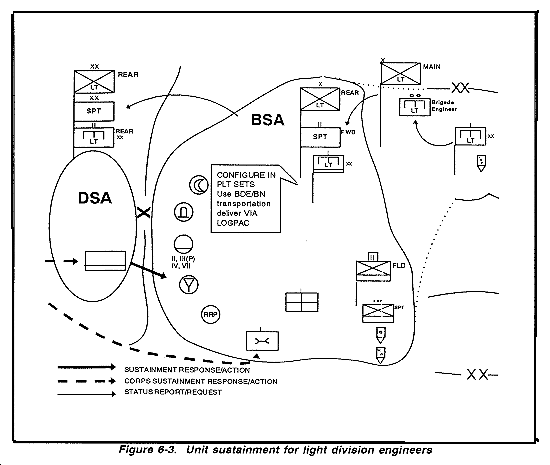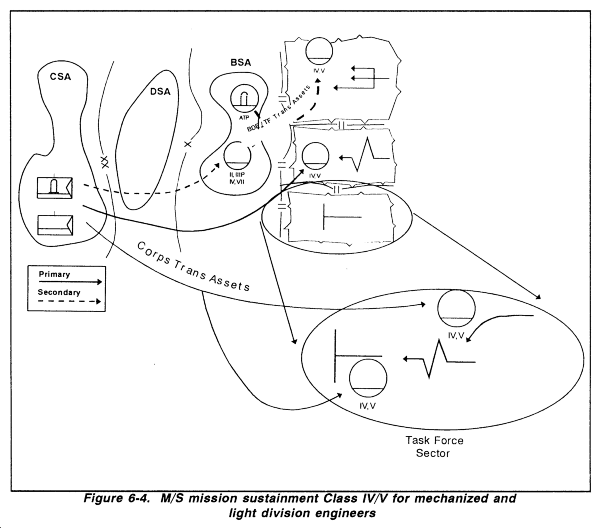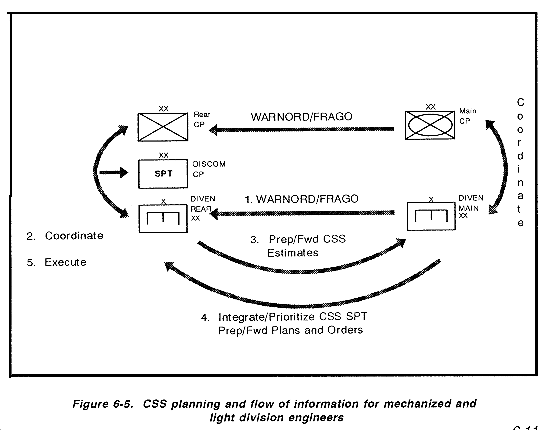CHAPTER 6
Combat Service Support
Sustainment is a critical element of combat power on the AirLand battlefield. Generating combat power requires the conversion of a force's potential, resources, and tactical opportunity into actual capability. Sustainment must support violent and coordinated action, allowing the division to concentrate at the decisive time and place. The ability to provide and sustain support for combat operations is predicated on thorough, integrated planning. Therefore, an inseparable relationship exists between operations, tactics, and sustainment during AirLand Battle operations.
The basic mission of CSS is to sustain the battle. The CSS system's sole purpose is to maintain and support our soldiers and their weapons systems. CSS operations must focus on sustaining the force as it executes the commander's intent while conducting deep, close, and rear operations. The measurement of sustainment success is the generation of combat power at the right place and time. CSS planners and executors must integrate with the planners for all organizations in order to provide the commander with the combat power to accomplish his mission. Sustainment planning must keep pace with the combat unit's rapid decision cycle. Sustainment execution must rapidly and thoroughly support current and future operations.
This chapter focuses on the role of the division engineer and staff in the sustainment of combat engineer units supporting division operations. It supplements CSS doctrine contained inFM 100-10, the Army's keystone manual for the CSS of combat and CS forces.
Sustaining combat engineer units is a complex mission that presents a unique challenge to the DIVEN headquarters. The special equipment needed to accomplish engineer missions requires intensive management of maintenance assets and supplies to support low-density engineer vehicles and special mobility and countermobility systems. Acquisition support and extensive transportation assets are often needed to obtain and move the materials necessary to accomplish engineer missions to the mission site. The lack of sufficient CSS assets organic to the division engineer organization requires coordinated linkage with the supported unit's sustainment structure. The dispersion of engineer units throughout the battlefield places a distinct need to streamline C2 while retaining effective engineer unit status reporting. The necessity to task organize for missions, shift assets to support the changing situation, and re-task organize in response to maneuver plans, while always maintaining continuous support, requires close adherence to the sustainment imperatives.
Meeting these challenges requires engineer sustainment planners and executors to have a clear understanding of tactical and sustainment doctrine and the division's SOPs. It also requires engineer planners to integrate completely into the division's C2 process. A thorough understanding of the engineer C2 structure, as outlined inChapter 2, is essential to planning and executing engineer sustainment successfully.
SUSTAINMENT IMPERATIVES
Sustainment planners and executors assist the commander in making the best use of available resources by following sustainment imperatives. These imperatives apply as much to engineer unit operations as to any other operations. Engineer commanders and their staffs must understand and use them while planning engineer operations.
Anticipation
Sustainment planners accurately forecast future requirements and accumulate the assets needed to accommodate likely contingencies. Engineer operations feature high fuel-consumption rates, repair parts, construction and obstacle materials, mines, and explosives. They require a large commitment of maintenance and transportation services. Engineer operations require finance services to support the local purchase of materials and services. Planners must anticipate personnel losses, critical replacement requirements, and necessary health services support. Because forward engineer units will likely depend on the CSS system of their supported unit, engineer planners must anticipate changes in task organization that redirect the flow of engineer sustainment.
Integration
Tactical plans must have fully integrated CSS. This is crucial for the engineer contribution to the overall plan since material, personnel, and services must be available at the right time and place for engineers to properly execute their missions. Integration tasks include the CSS needed to sustain both engineer units and their missions.
Continuity
Committed forces must receive continuous replacements, supplies, and services to maintain their fighting strength. Engineer units are always committed to either the current battle or preparation for the next battle. They need a constant flow of supplies and services to remain effective and productive. Maneuver units often rely on lulls in the tempo of an operation to conduct CSS operations. Engineers are not routinely afforded the same opportunity since many logistics-intensive mobility, countermobility, and survivability missions occur during lulls in the operation. This increases the engineer sustainment planner's responsibility to integrate continuous routine and emergency CSS operations into the tactical plan.
Responsiveness
The sustainment system must keep pace with rapid decision cycles and mission execution and react rapidly to crises or opportunities. The sustainment system must respond to the changing situation and the shifting of engineer units around the battlefield. Engineer sustainment planners must be particularly conscious of engineer task organization changes. When such changes occur, sustainment assets must be rapidly redirected to the receiving unit, making maximum use of the established division CSS structure. Since a unit can normally respond to re-task organization much quicker than its support can, interim contingency sustainment plans to support the re-task organized units must be developed.
Improvisation
CSS organizations must improvise to meet current needs and respond to unforeseen emergencies. Their success greatly influences the extent to which engineers must also improvise.
The sustainment system must support engineer operations in two ways. It must provide the support that engineer units need to exist (unit sustainment), and it must provide the mission-specific materials and transportation engineers needed to accomplish their battlefield missions (mission sustainment).
CSS TASKS
Simply stated, CSS tasks are to man, arm, fuel, fix, and move the force. These tasks are generally categorized into logistics support, personnel service support, and health services support.
Logistics support includes--
- Supply.
- Transportation.
- Maintenance.
- Field services.
Personnel service support includes functions that provide soldiers to the command as well as contribute to their welfare and morale. Major personnel service support functions are--
- Personnel and administration services, including strength and personnel accounting, casualty reporting, replacement operations, awards, and personnel management.
- Chaplain operations.
- Enemy prisoner of war (EPW) operations.
Health services support includes--
- Medical treatment and evacuation of casualties.
- Preventive medicine.
- Medical supply operations.
Engineer sustainment planners and executors must focus on several essential areas to accomplish these tasks successfully. First, the engineer CSS planner must keep pace with the division's decision cycle through early, complete, and continuous integration into the division's C2 and CSS structure. They must be able to plan and adjust engineer sustainment in concert with the rapid division planning process. Second, tracking both subordinate and supporting engineer units' sustainment postures allows the sustainment planner to account for available resources, shift them as necessary, and integrate them into planning future operations. Third, detailed coordination with the division's CSS units allows engineer sustainment planners to influence current and future operations by ensuring that continuous and responsive CSS is maintained.
DIVISION ENGINEER CSS CONCEPT
This section addresses the CSS concept for both mechanized and light division engineer units unless otherwise specified.
The DISCOM provides division-level logistics support and health services support to organic and attached units of the division through its main and forward support battalions. However, nondivision units operating in the division area may receive their logistics support from corps logistics units operating in and immediately rear of the division. Health services support requirements for nondivision units are absorbed into the existing division medical support structure which is augmented by corps medical units.
Personnel service support for the division is managed by the Assistant Chief of Staff, G1 (Personnel) (G1)/Adjutant General (AG) and supported by a DS corps personnel services company (PSC). Additional PSCs may augment nondivisional units that support a division, depending upon the unit size, or personnel service support may be absorbed by the DS PSC.
While the DISCOM commander is the principal logistics executor within the division, the division's G4 has coordinating staff responsibility for CSS planning and establishing policies and priorities. Together, they ensure adequate and continuous sup port for division units. Support for nondivision units is provided by the corps support group that works both in and to the rear of the division sector. Integration of nondivision units into the division CSS structure is conducted through the DISCOM and the corps support group's liaison officer (LNO), normally located in the DISCOM CP.
The DISCOM's main support battalion (MSB) provides logistics support and health services support to division units located in the division rear. Figure 6-1 shows an organization by area schematic of division and corps CSS units located in the DSA. The DISCOM MSB also augments the forward support battalion (FSBs). The FSBs provide logistics support and health services support to the units located in maneuver brigade areas.
Engineer CSS Laydown
Logistics support, health services support, and personnel service support for engineer units supporting a division will depend upon their location on the battlefield and their command support relationship to the supported unit. In terms of planning and integration, engineer units fall into three types:
- Engineer units in support of maneuver brigades in close operations.
- Engineer units supporting the division rear operations.
- The division engineer's HHD (mechanized) and HHC (light).
The division engineer's HHD (mechanized), like a maneuver brigade, has no organic capability to sustain its subordinate units. Therefore, division engineer units must rely on division CSS assets for sustainment. The DISCOM has the capability to tailor sustainment support for the close fight through its FSBs that directly support maneuver brigades.
The division engineer's HHC (light) has the organic capability to provide limited CSS to its subordinate units. Division light engineer battalion field trains operations will be discussed later in this chapter.
Division engineer units supporting maneuver brigades in close operations receive their logistics support and health services support from FSBs located in the BSA. Personnel service support, minus promotions and transfers, is obtained through direct coordination between the division engineer battalion Adjutant (US Army) (S1) and the maneuver brigade S1.
The FSBs, augmented by corps CSS assets, provide logistics support and health services support to nondivision engineer units supporting maneuver brigades in close operations. Special support packages from the corps support group are tailored and sent to the BSA to support nondivision units that support maneuver brigades through direct coordination with the corps support group LNO collocated with the DISCOM CP. Personnel service support remains with corps personnel units that locate in the DSA.
The DS corps support battalion provides logistics support and health services support to nondivision units supporting operations in the division rear area. Personnel service support is obtained through the direct coordination with corps personnel units in the DSA.
The division engineer CPs normally locate close to the division's CPs and receive support in conjunction with their respective division CP. Division CPs receive their logistics, personnel service, and health services support from the MSB through the division HHC. When a consolidated division engineer CP is established, the HHD (mechanized) must still receive its support by working through the division HHC and the MSB. When a consolidated division engineer CP is established, the HHC (light) is capable of self-sustainment through the MSB.
Regardless of the command or support relationship and location on the battlefield, all engineer units operating in the division's area must provide routine CSS status reports through the appropriate headquarters to ensure that the CSS of engineer units and missions is fully integrated into the division's planning and coordination of sustainment support.
Flow of Support
CSS for engineer units supporting a division is divided in two basic categories, unit sustainment and mission sustainment. Unit sustainment encompasses all of a unit's CSS requirements needed to remain a viable fighting force. Mission sustainment consists of the supplies needed to accomplish specific engineer missions for the division. The flow of supplies and services in these categories differs and must be understood by engineer CSS planners and executors. Figures 6-2 and 6-3 and Figure 6-4, show the flow of supplies for unit and mission sustainment. The requisition and delivery processes vary, based on the class of supply or type of service. Unit sustainment, however, is generally accomplished through the DISCOM infrastructure to service forward engineer units. Division engineer units (regardless of their location in the division area) and corps engineer units supporting the close fight requisition and receive support through the division's DISCOM. Supply and services for nondivision engineer units working in the division rear area are normally requisitioned through the corps support battalions and corps personnel units supporting them. Mission sustainment requires supplies, such as Class IV/V, that are used to install or breach obstacles both in the offense and defense. These supplies are requisitioned through the DISCOM for both division and non-division engineer units. These supplies are normally moved from corps supply and ammunition companies by corps trucks as close to the obstacle locations as possible. This minimizes multiple material handling requirements, reduces the transportation requirements on division transportation assets, and facilitates a faster emplacement of the obstacles. If mission-required supplies cannot be delivered directly to the obstacle locations or engineer unit by corps transportation assets, a plan using division and task force transportation assets is required. Engineer units are equipped to augment this operation with limited transportation assets but are not responsible for planning, controlling, and executing the delivery of mission-required material.
Division engineers can influence both unit and mission sustainment requirements through early integration into the sustainment planning process at the main and rear CPs. Sound sustainment estimates, accurate tracking of engineer unit sustainment posture, and continuous coordination with the DISCOM to ensure that requirements for engineer units are properly forecasted, prioritized, and delivered will assist engineer units in accomplishing their mission. Crucial to accomplishing these tasks are the responsibilities of the engineer organization's key CSS leaders and their functions within the division and engineer CP systems. All engineer commanders and staffs supporting a division's fight must be familiar with and support these roles and functions in order to ensure appropriate unit and mission sustainment of the engineer force.
Key Engineer CSS Leaders
Executive Officer (XO). In addition to his second-in-command (2IC) duties, the XO is responsible for synchronizing all CSS operations in the engineer brigade. He is responsible for directing the execution of engineer staff CSS tasks, coordinating the effort of staff members, and supervising the efficient and prompt response of the staff CSS functions. He relies on the administration/logistics section (with representation in the engineer REAR and MAIN) to plan, integrate, request, and monitor engineer CSS functions that support both engineer unit sustainment and supplies and services needed to accomplish the division's engineer missions.
ADE. The ADE is responsible for writing and integrating engineer-specific information for inclusion in division orders, including CSS. The ADE ensures that essential engineer CSS requirements are identified, coordinated, and published. The ADE is assisted in this task by the division rear CP engineer, the division engineer REAR, and the division engineer MAIN, as necessary.
Division Rear CP Engineer. The division rear CP engineer is responsible for identifying requirements and ensuring that logistics are coordinated for engineer units operating in the division area. The division rear CP engineer is assisted in this task as necessary by the division engineer REAR and MAIN CPs.
S1. The S1 is responsible for engineer integration with the division staff and CSS organizations for personnel service support and general administrative functions. The S1 must be cross trained with the Supply Officer (US Army (S4) in all areas of engineer sustainment.
The S1 ensures coordination with the G1/AG staff in the division rear CP and the division's supporting PSC in executing the personnel services and general administration functions.
S4. The S4 is responsible for engineer integration with the G4 staff in the division rear CP and the collocated DISCOM CP in the DSA in order to plan, coordinate, and monitor logistics operations for organic engineer units that remain under division control. He provides detailed sustainment input to division engineer MAIN for orders development for each mission. The S4 closely monitors and accurately tracks the sustainment status and requirements of forward engineer battalions through the division engineer MAIN and engineer units working in the division rear through his own CP. He is assisted by a chief supply sergeant and supply specialists for supply-related functions. He is also assisted by the maintenance technician warrant officer and senior maintenance supervisor for troubleshooting maintenance operations and support. The S4 should be fully cross trained in S1 operations in order to provide assistance and supervision to the personnel services noncommissioned officer (PSNCO) in the absence of the S1.
HHD Commander. The division engineer HHD commander commands the HHD CP and is assisted by the HHD detachment sergeant. The commander is responsible for coordinating sustainment of the division engineer CPs and the division engineer command group. He ensures coordination and integration with the division HHC and MSB by providing the requirements necessary to support these elements, tracking their sustainment status, and responding to their problems. The HHD commander may be required to perform staff functions in the division engineer REAR, underscoring the importance of the detachment sergeant as the assistant HHD CP commander and coordinator of the sustainment plan to support the dispersed DIVEN HHD.
Division Light Engineer Battalion HHC Commander. The division light engineer battalion HHC commander commands the engineer battalion field trains. He is responsible for the sustainment of all division light engineer battalion organizations operating in the division rear area. Additionally, he coordinates the support of the battalion A&O platoon assets supporting the close fight.
Key Engineer CSS Headquarters
Division engineer CSS C2 for the division centers around the DIVEN MAIN and REAR but pervades all engineer C2 nodes. Each engineer CP has specific responsibilities in identifying requirements, estimating resources, integrating into the division's planning and decision cycle, and monitoring the execution of engineer sustainment missions.
DIVEN REAR. The DIVEN REAR is the DIVEN headquarters' primary integrator into the execution of CSS for the DIVEN commander's subordinate units. The DIVEN REAR also supports the division rear CP engineer as he integrates engineer CSS with the division. The rear CP engineer coordinates sustainment for current operations and plans and prepares for implementation of future operations. The DIVEN REAR's sustainment missions consist of responsibility for maintaining updated CSS status of engineer units, providing the DIVEN MAIN detailed CSS estimates to assist in formulating division plans and orders, and ensuring that engineer sustainment plans for both division and nondivision engineer units are synchronized with the DISCOM.
DIVEN MAIN. The DIVEN MAIN supports the ADE in the division main CP. The DIVEN MAIN assists the ADE in developing the engineer sustainment plan and writing the engineer CSS portions of the basic division OPLAN or OPORD and paragraph 4 of the engineer annex. The ADE integrates engineer sustainment into division operations through coordination with the CSS cell in the division tactical operations center (DTOC), the part of the DIVEN MAIN CP that runs the battle and coordinates CS and CSS. The DIVEN MAIN or ADE ensures that immediate sustainment requests received from the DIVEN TAC or division TAC CP are forwarded to the DIVEN REAR or division rear CP for execution.
DIVEN TAC. The DIVEN TAC has limited capability to impact CSS operations from this location. Its primary CSS duties are supporting the division TAC CP engineer and receiving and forwarding reports and influencing the redirection of sustainment priorities for the forward engineer battalions.
DIVEN HHD CP. The DIVEN HHD establishes a CP at or in close proximity to the DIVEN REAR. The HHD CP is responsible for the sustainment of the HHD. This includes coordinating sustainment support for all DIVEN CPs and the DIVEN command group. From the HHD CP, the administrative and logistics section conducts close coordination with the DIVEN REAR to monitor the status of replacements, maintenance, and requisitions for supplies and services that support the engineer units commanded by the DIVEN commander.
Division Engineer Role in Planning and Coordinating CSS
The DIVEN organization's efforts to plan and coordinate engineer CSS are essential to full integration of engineer units into the division's sustainment structure. The ADE (assisted by the DIVEN MAIN), the division rear CP engineer (assisted by the DIVEN REAR), the DISCOM, and the G4 work closely to synchronize the planning and coordination process and facilitate sound and timely plans or orders and sustainment for engineer units.
Upon receipt of the WARNORD for a mission, the division rear CP engineer, assisted by the DIVEN REAR, immediately initiates the CSS estimate process as outlined in FM 101-10-1/2. These estimates are specifically focused on the sustainment of all subordinate engineer units organic or attached to the division. Class I, III, IV, and V supplies and personnel losses are the essential elements in the estimate process. Close integration with the DISCOM can simplify and speed this process through the use of their automated data processing (ADP) systems. During continuous operations, the estimate process may need to be abbreviated due to time constraints. Aggressively maintaining an accurate combat status of all engineer units is critical to shortening the CSS estimate process.
Having conducted the estimate process to determine the unit sustainment and mission supplies requirements, the division rear CP engineer compares the requirements with the reported status of subordinate units to determine specific amounts of supplies needed to support the operation. These requirements are then coordinated with the DISCOM to ensure that necessary supplies are identified and resourced through division or corps stocks.
Simultaneously, the ADE, assisted by the DIVEN MAIN, develops a required supply rate (RSR) to support engineer mission requirements and forwards it to the division rear CP engineer. Based on the division's current stockage of required items and the identification of additional supplies needed, the division rear CP engineer, in coordination with the G4, assesses the availability of these supplies in corps stocks. The division rear CP engineer and G4 also analyze the division's capability to transport mission supplies to the user.
Having identified the requirements for both unit sustainment and engineer mission supplies and their availability, the requirements are forwarded to the ADE, along with a projected combat power status, based on current engineer sustainment operations. The ADE then analyzes the requirements to support the plan and translates them into specific plans that are used to determine the supportability of division courses of action. Upon determination of a course of action, the specific CSS input to the division's basic order and paragraph 4 of the engineer annex are developed and incorporate into the order. Current sustainment operations may require redirection based on the new plan and will be sent to the division rear CP engineer for coordination and execution. Figure 6-5 shows the CSS planning and coordination flow within the DIVEN CP system.
The DIVEN commander also has essential CSS tasks involving nondivision engineer units. First, the DIVEN headquarters monitors the sustainment status of nondivision engineer units. Nondivision engineer unit commanders and their staffs must support this requirement. Accurate and timely status reporting will assist the DIVEN commander in providing accurate engineer status to the division commander and energize the DIVEN staff support to intercede in critical sustainment problems where necessary. The DIVEN staff also ensures that mission-required supplies needed by nondivision engineer units to execute missions for the division are integrated into the division's CSS plans. Accurate and timely reporting and close coordination between the DIVEN staff and supporting nondivision engineers are essential for proper execution of the missions. The concept of the CSS planning and coordination process is essentially the same.
LIGHT FORCES
Light Division CSS Concept
Light and armored divisions have similar support structures to sustain their operations. The previous discussion of the armored division CSS concept and the flow of support is generally applicable to light divisions and their supporting engineers.
The major difference is that the light engineer battalion field trains play an active role in the sustainment of both HHC organizations and engineer battalion subordinate units operating in the division rear area.
Division Light Engineer Battalion Field Trains Operations
The division light engineer battalion field trains is configured to support the division light engineer battalion when operating as a complete unit or those subordinate units that operate in the division rear area. The field trains can also provide limited support packages to partially sustain subordinate units when they are task organized to maneuver brigades committed to the close fight. The field trains contains the following organizations:
- Company headquarters.
- Mess section.
- S1 and S4 sections.
- Communications section.
- Battalion maintenance section.
- Medical section.
Company Headquarters. The division light engineer battalion HHC headquarters commands and controls the battalion field trains through the field trains CP. The field trains CP is located in or as close as possible to the DIVEN REAR in the DSA. The primary function of the field trains is to ensure the sustainment of the engineer battalion during consolidated operations and HHC assets when the battalion is dispersed. It also provides a sustainment base for all battalion assets not deployed in the close fight.
Mess Section. The mess section operates under the control of the HHC in the battalion field trains when the majority of the division light engineer battalion operates together. When the division light engineer companies are task organized to maneuver brigades, the mess section may collocate with the division HHC mess section to assist in the support of the dispersed engineer CPs.
S1 Section. Elements of the S1 section operate in the battalion field trains and execute the battalion's personnel services and general administration. S1 personnel in the field trains CP perform the critical tasks of strength accounting and casualty reporting, replacement operations for all division light engineer battalion organizations in the division rear area, administrative services, personnel actions, and limited legal and financial services. They also support the HHC commander by performing CP functions.
S4 Section. Elements of the S4 section operate in the division light engineer battalion field trains and primarily focus on battalion supply functions. This includes direct coordination with DISCOM and the MSB to ensure the flow of critical mission supplies to the forward division engineer companies through the FSBs. Additionally, they support the HHC commander in general CP duties.
Communications Section. The communications section supports the division light engineer battalion subordinate units operating in the division rear area with organizational maintenance. They are responsible for the evacuation of communications assets to DS level maintenance. They also provide assistance to the field trains CP for general CP duties as required.
Maintenance Section. The maintenance section supports the division light engineer battalion with organizational maintenance. It provides maintenance contact teams to support the A&O platoon when it operates in support of the close fight.
Medical Section. The medical section is task organized to provide medical support to division light engineer companies by providing a combat medic to each combat platoon. The senior medic provides combat medic support to the field trains CP.
Division Light Engineer Battalion Field Trains Functions. The division light engineer battalion field trains have the following major functions:
- Establishing and maintaining the field trains CP.
- Coordinating support for the DIVEN CPs.
- Sustaining division light engineer companies operating in the division rear area.
- Supporting the A&O platoon during rear operations and coordinating support during forward operations.
- Self-sustainment.
Sustainment of the DIVEN CPs and the DIVEN command group is coordinated and executed by the field trains CP. The HHC commander ensures integration with the main support battalion through the division HHC by providing the sustainment requirements necessary to support the DIVEN CPs and command group, tracking their sustainment status, and responding to their problems.
The field trains support division light engineer companies with unit sustainment requirements when they are conducting rear operations and not yet task organized with a maneuver brigade. A logistical package (LOGPAC) system is executed using internal battalion assets, drawing the necessary supplies from the MSB. DS maintenance and health services support are obtained through direct coordination between the field trains and the MSB.
The field trains provide unit sustainment for the A&O platoon when they conduct rear operations. The HHC conducts a company LOGPAC drawn from the MSB. Since the HHC has limited fuel-hauling capacity, special coordination must be made for direct delivery by MSB assets or tying in with the fueling plan of the unit they support. Organizational maintenance contact teams are organized to support the maintenance effort of the A&O platoon equipment. DS maintenance and health services support are obtained through the MSB's maintenance and medical companies.
The field trains CP coordinates the A&O platoon's sustainment when they are task organized to support maneuver brigades in the close fight. This is done through the DIVEN REAR or the engineer unit supporting the maneuver brigade. If no other engineer unit is supporting a maneuver brigade, coordination is made through the DIVEN REAR with the maneuver brigade's supporting FSB. The brigade engineer can assist, when needed, to influence this relationship. The MSB is capable of sending an engineer maintenance team to the FSBs to sustain engineer equipment supporting the close fight. Health services support must be coordinated through the closest unit.
The field trains must also be self-sustaining. The HHC first sergeant (1SG), assisted by the supply noncommissioned officer (NCO), plans and executes the sustainment of the HHC. Class I supplies are obtained through the battalion mess section. Other normal unit sustainment needs are fulfilled by routine supply runs to the MSB.
|
NEWSLETTER
|
| Join the GlobalSecurity.org mailing list |
|
|
|


